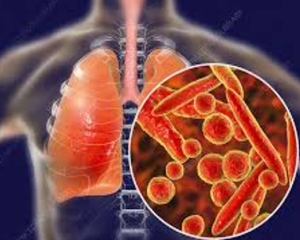Mycoplasma pneumoniae is a small bacterium which causes atypical pneumonia in young adults.
肺炎支原体是一种小细菌,可引起年轻群体的非典型肺炎。
Mycoplasma, as a genus, have a cell membrane that is packed with sterols, but they lack a proper, rigid cell wall.
支原体属有一个充满固醇的细胞膜,但它们缺少一个适当的、坚硬的细胞壁。
Therefore, they don't take up dye under Gram staining, so they can't be visualized with light microscopy.
所有在使用革兰氏染色方法时,它们不会上染,因此也就无法用光学显微镜观察到它们。
Additionally, they are highly pleomorphic bacteria, meaning they have no fixed shape and size, and they're also osmotically unstable in the external environment.
此外,它们是高度多形性的细菌,这意味着它们没有固定的形状和大小,而且它们在外部环境中渗透性也不稳定。
So, to survive, Mycoplasmas invade host cells and live intracellularly.
因此,为了生存,支原体会侵入宿主细胞并在细胞内生存。
Now, Mycoplasma pneumoniae is a facultative anaerobe, meaning it can live without oxygen if it has to, but it grows better in an aerobic environment.
肺炎支原体是兼性厌氧菌,也就是说,如果有必要,它可以在没有氧气的情况下生存,但它在有氧环境中生长得更好。
So it prefers places like lungs or respiratory airways, where there is an unlimited flow of oxygen.
所以它更喜欢肺或呼吸道这样的地方,那里有无限的氧气流。
As a result, some people may carry this bacteria in their nose or throat, and when they sneeze or cough, these organisms get out in the form of small respiratory droplets.
因此,有些人的鼻子或喉咙中可能会携带这种细菌,当他们打喷嚏或咳嗽时,这些微生物以小的呼吸道飞沫的形式排出体外。
And when other people inhale these droplets, they may get infected, especially when they spend a lot of time together in close quarters.
当其他人吸入这些飞沫时,就可能会被感染,尤其是当他们长时间在一起近距离接触时。
So Mycoplasma pneumoniae infections happen mostly in children who go to school, young adults in college, or military recruits.
因此,肺炎支原体感染主要发生在上学的儿童、大学里的年轻人或新兵当中。
Following inhalation of the pathogen droplets, Mycoplasma pneumoniae attaches to an epithelial cell in the respiratory tract,
吸入病原体飞沫后,肺炎支原体会附着在呼吸道的上皮细胞上,
using a specialized attachment organelle which has an adhesive protein complex, called 'adhesion protein P1' at its tip.
使用一种特殊的附着细胞器,其尖端有一种叫做“黏附蛋白P1”的黏附蛋白复合体。

Adhesion protein P1 attaches to the host cell surface, like the respiratory epithelial cell, and holds on for dear life.
黏附蛋白P1会附着在宿主细胞表面,比如说呼吸上皮细胞,并维持生命。
This makes it away harder for the mucociliary clearance mechanisms, which normally remove any foreign pathogen out of the respiratory tract, to clear the bacteria.
这会使得粘液纤毛清除系统更难清除细菌,粘液纤毛清除系统通常是会清除掉呼吸道中的外来病原体的。
So Mycoplasma pneumoniae multiplies and damages the respiratory epithelial cells in the process.
肺炎支原体会在此过程中繁殖,并损害呼吸道上皮细胞。
When they reach the lungs, this starts a local inflammatory response, and lung tissue fills with white blood cells, proteins, fluid,
当它们到达肺部时,就会引发局部炎症反应,肺组织充满白细胞、蛋白质、液体,
and even red blood cells if a nearby capillary gets damaged in the process -- leading to a local cytotoxic effect.
即使是红细胞,如果附近的毛细血管在这个过程中受损,也会导致局部细胞毒性作用。
So Mycoplasma pneumoniae avoid the battlefield by sneaking inside lung cells, where they remain dormant or replicate intracellularly.
因此,肺炎支原体会通过潜入肺细胞内的方式来避开战场,在那里保持休眠或在细胞内复制。
As a result, individuals infected by Mycoplasma pneumoniae are often asymptomatic or may have nonspecific symptoms like fatigue, sore throat, mild fever and dry hacking cough
结果就是,感染肺炎支原体的个体通常无症状或可能有非特异性症状,如疲劳、喉咙痛、轻度发烧和干咳
all of which aren't typical of bacterial pneumonia -- hence the name atypical pneumonia.
所有这些都不是典型的细菌性肺炎,因此被称为非典型肺炎。
Mycoplasma pneumoniae can also cause encephalitis, especially following atypical pneumonia in children.
肺炎支原体也可引起脑炎,尤其是其发病于儿童群体当中。
Symptoms of encephalitis include fever, changes in mental status, and neck stiffness.
脑炎的症状包括发烧、精神状态改变和颈部僵硬。
Diagnosing a Mycoplasma pneumoniae infection requires a chest X-ray -- which reveals a patchy infiltrate, that denotes severe infection.
诊断肺炎支原体感染需要胸部X光检查,如果结果显示有斑片状浸润影,就表明感染较为严重。
Alright, atypical pneumonia is generally self-limiting.
非典型肺炎通常来说是自限性疾病。
But, if it doesn't resolve on its own, antibiotics are needed.
但是,如果它不能自行消退,就需要抗生素。
And since mycoplasmas don't have a cell wall, cell wall inhibitors like beta-lactam antibiotics are inefficient
由于支原体没有细胞壁,因此像β-内酰胺类抗生素这样的细胞壁抑制剂是无效的。
so treatment relies on antibiotics that inhibit protein biosynthesis, like tetracyclines, or macrolides like erythromycin and azithromycin.
所以治疗手段主要是靠抑制蛋白质生物合成的抗生素,如四环素,或大环内酯类药物,如红霉素和阿奇霉素。


